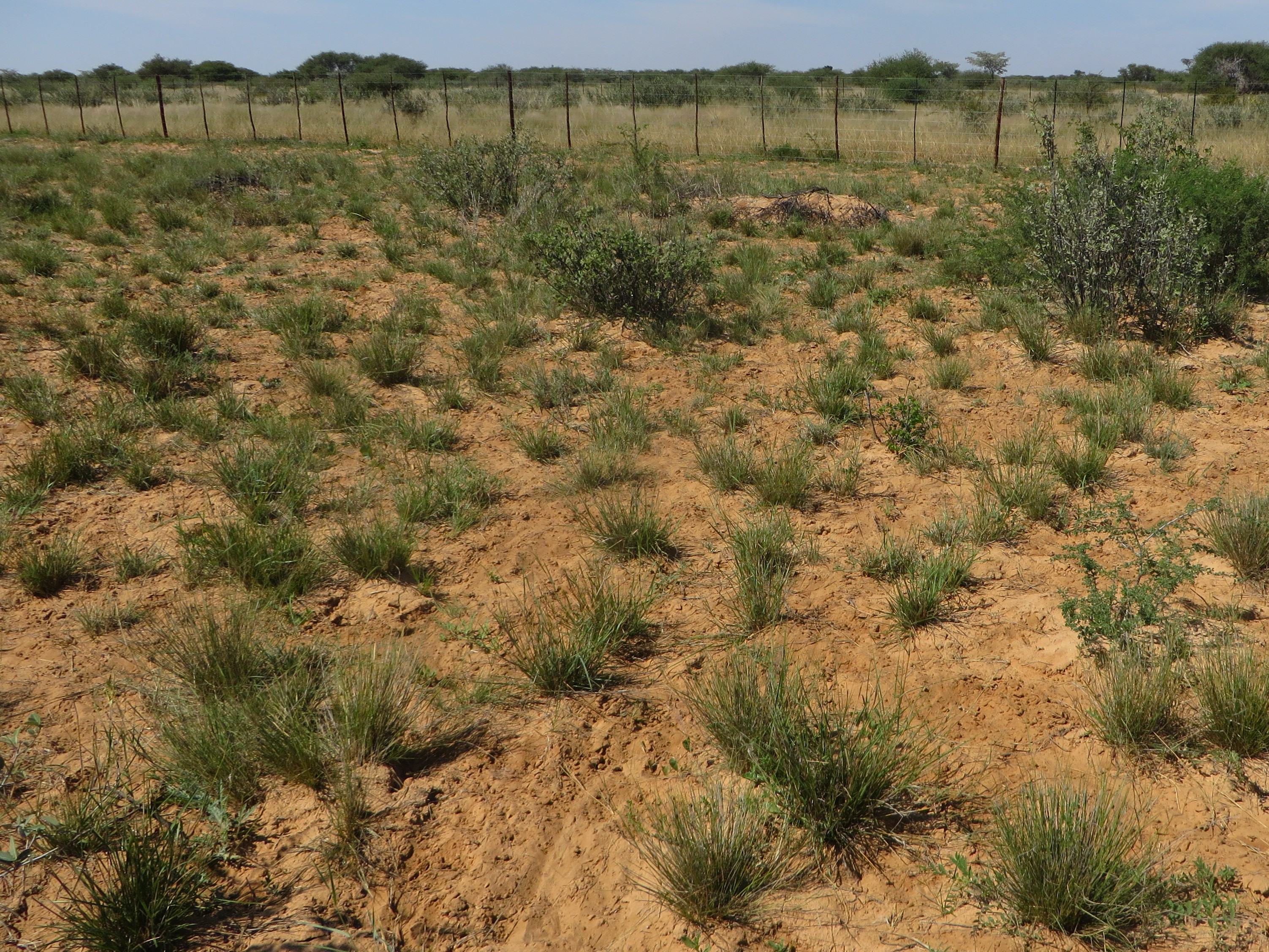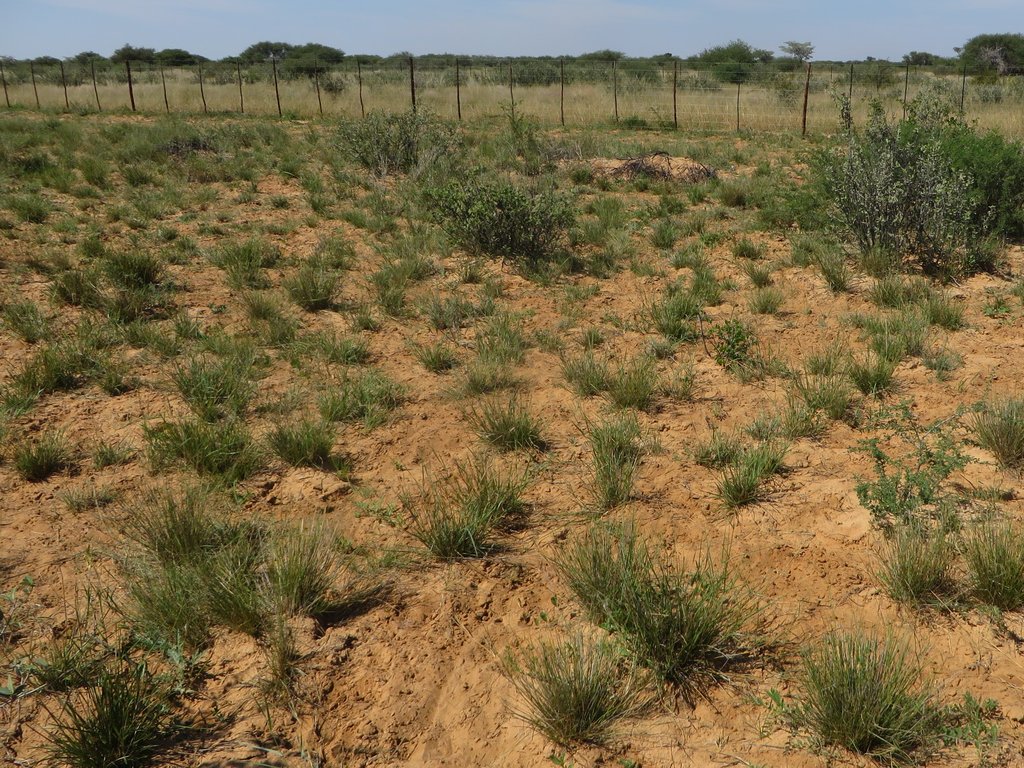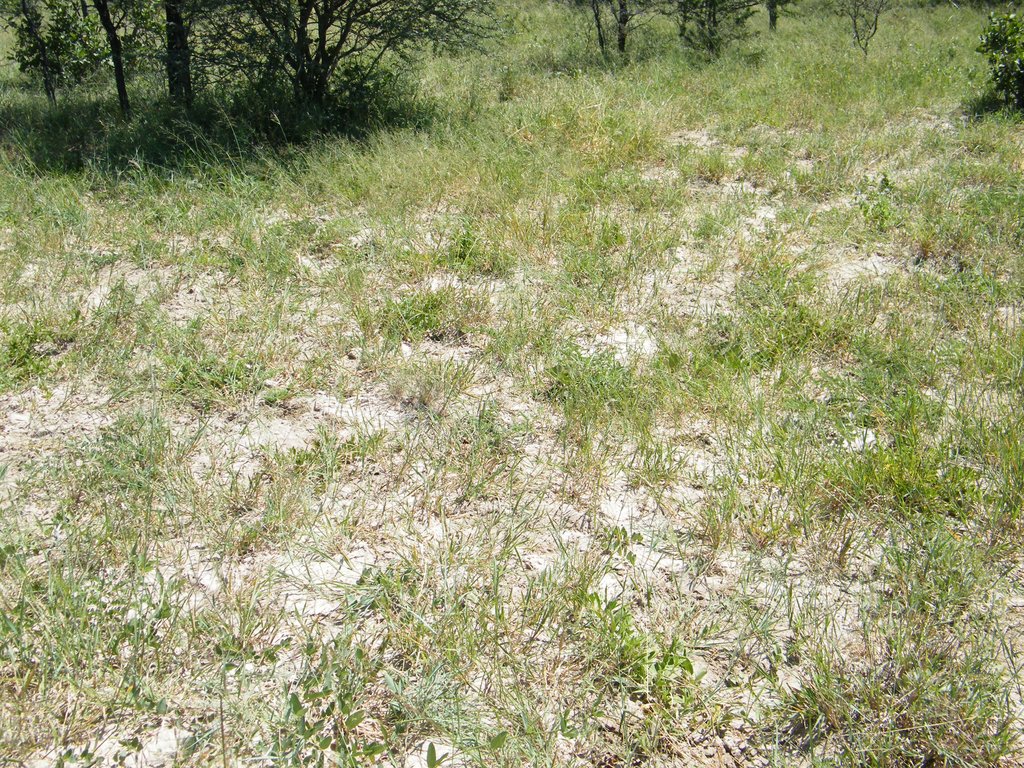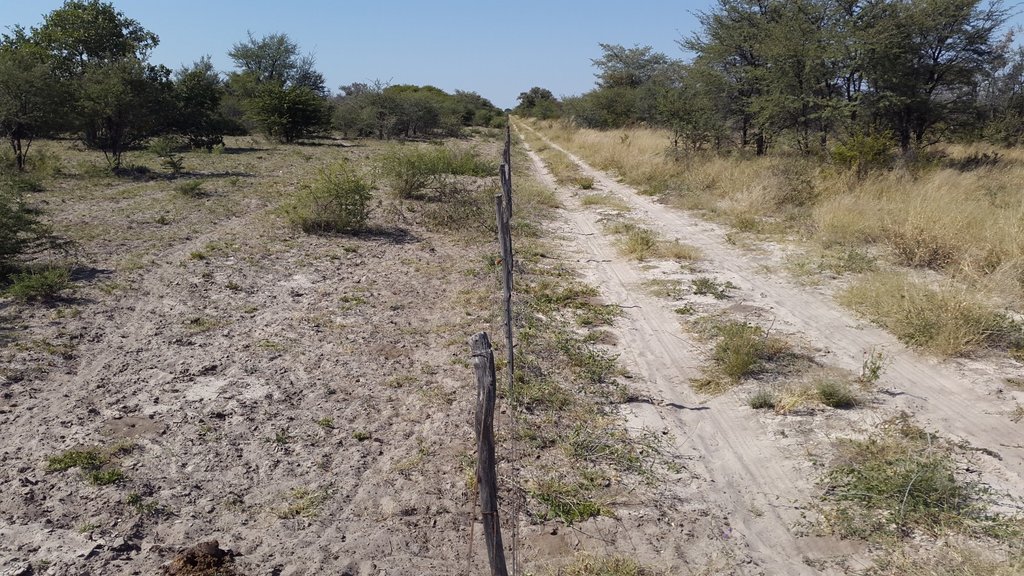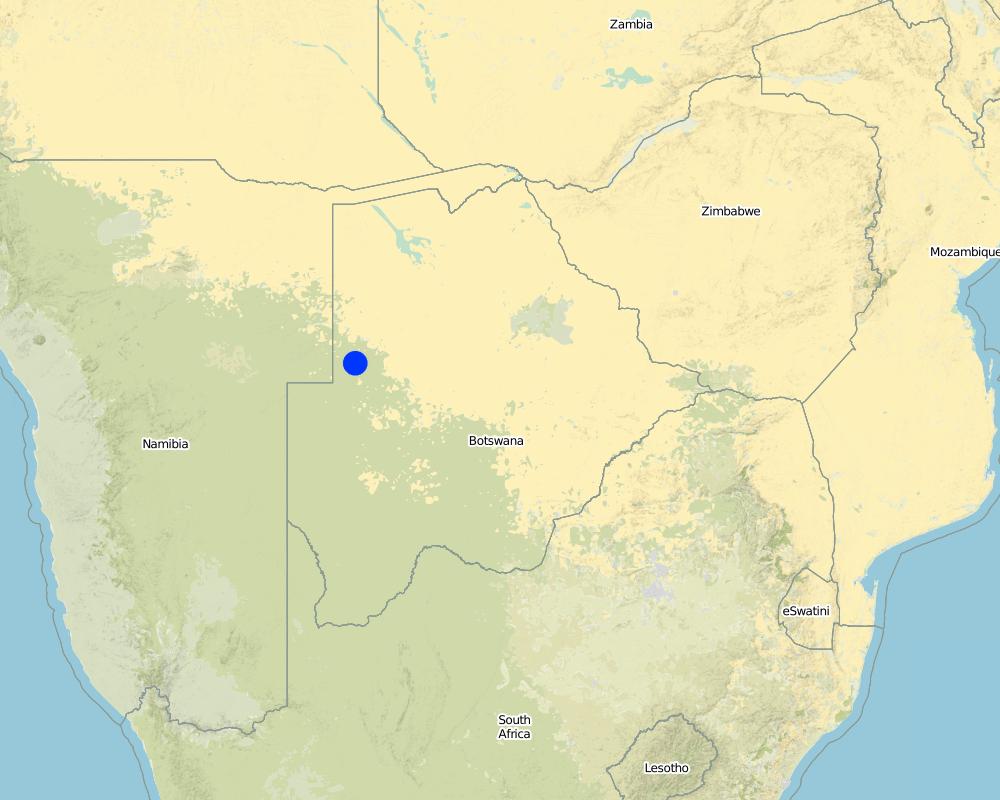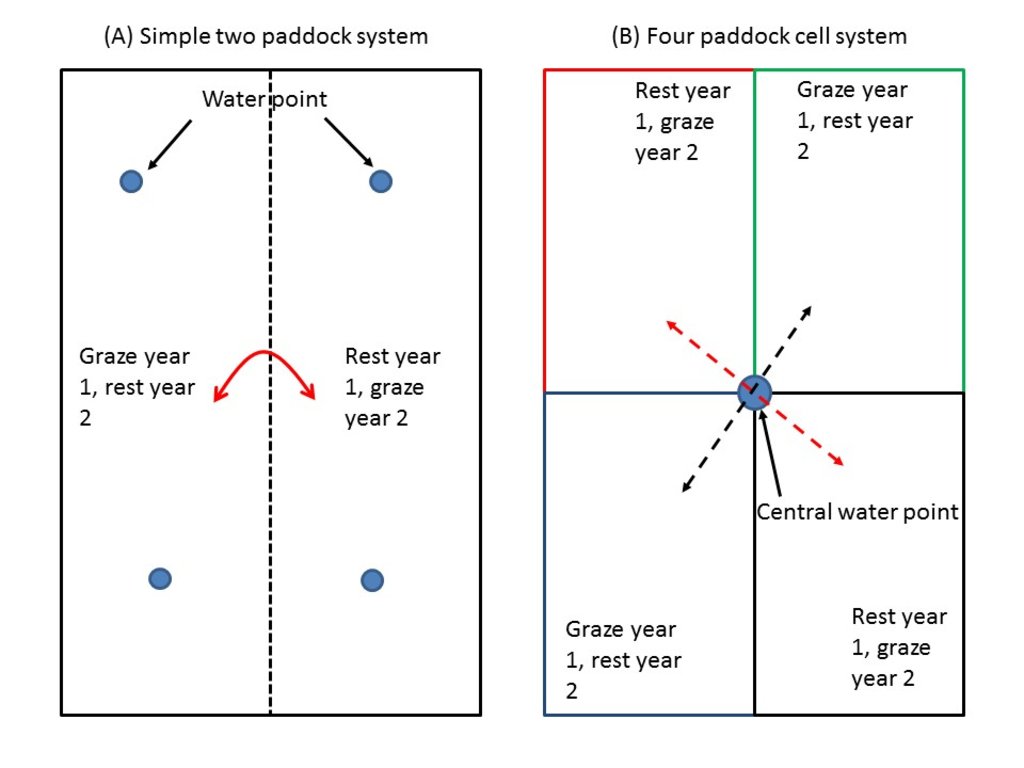Split Ranch Grazing Strategy [Botsuana]
- Criação:
- Atualização:
- Compilador/a: Richard Fynn
- Editor: –
- Revisores: Donia Mühlematter, Simone Verzandvoort, Rima Mekdaschi Studer
Riaan Dames Grazing Strategy
technologies_3217 - Botsuana
- Resumo completo em PDF
- Resumo completo em PDF para impressão
- Resumo completo no navegador
- Resumo completo (sem formatação)
- Split Ranch Grazing Strategy: 10 de Agosto de 2018 (inactive)
- Split Ranch Grazing Strategy: 22 de Outubro de 2018 (inactive)
- Split Ranch Grazing Strategy: 7 de Março de 2019 (inactive)
- Split Ranch Grazing Strategy: 13 de Maio de 2018 (inactive)
- Split Ranch Grazing Strategy: 22 de Maio de 2018 (inactive)
- Split Ranch Grazing Strategy: 23 de Maio de 2018 (inactive)
- Split Ranch Grazing Strategy: 26 de Fevereiro de 2018 (inactive)
- Split Ranch Grazing Strategy: 2 de Novembro de 2021 (public)
- Split Ranch Grazing Strategy: 13 de Maio de 2018 (inactive)
- Split Ranch Grazing Strategy: 19 de Janeiro de 2018 (inactive)
Veja as seções
Expandir tudo Recolher tudo1. Informação geral
1.2 Detalhes do contato das pessoas capacitadas e instituições envolvidas na avaliação e documentação da tecnologia
Pessoa(s) capacitada(s)
Especialista em GST:
Nome da(s) instituição(ões) que facilitou(ram) a documentação/ avaliação da Tecnologia (se relevante)
University of Botswana (University of Botswana) - Botsuana1.3 Condições em relação ao uso da informação documentada através de WOCAT
Quando os dados foram compilados (no campo)?
2017
O/a compilador/a e a(s) pessoa(s) capacitada(s) aceitam as condições relativas ao uso de dados documentados através da WOCAT:
Sim
1.4 Declaração de sustentabilidade da tecnologia descrita
A tecnologia descrita aqui é problemática em relação a degradação da terra de forma que não pode ser declarada uma tecnologia de gestão sustentável de terra?
Não
2. Descrição da tecnologia de GST
2.1 Descrição curta da tecnologia
Definição da tecnologia:
Split Ranch Grazing involves grazing half the available area for a full year - concentrating livestock. The consequent grazing pressure maintains the grassland in an immature, high-quality state, while resting the other half, allowing optimal recovery from the previous full years grazing. The technology is simple, requiring less fencing than more complex systems, without compromising sustainability or ecological function. These concepts can also be used for management in pastoral-wildlife systems to create habitat heterogeneity (short and tall grassland).
2.2 Descrição detalhada da tecnologia
Descrição:
The Split Ranch Grazing Strategy (SRG) was developed by Riaan Dames in the North West province, South Africa. It is fundamentally different to popular rotational management systems and contains several conceptual advances. One key difference is that SRG provides a full-year uninterrupted recovery period for rangeland after grazing. This enables grasses to maximize nutrient recovery over the main pulses of nutrient mineralization in the early wet season, and to maximize root growth and associated nutrient storage over the late wet season and early dry season - when most root growth occurs. Optimal recovery periods should ideally, therefore, encompass the full wet season and the early dry season. This contrasts with rotational grazing where recovery and grazing periods are apportioned across these two periods, with resting periods often not occurring in key periods of nutrient uptake and root growth.
A major problem with having both grazing and recovery periods in the same season is that grassland is able to mature during recovery periods, greatly reducing forage quality and grass growth rates, thereby negatively impacting animal production. Another problem is that complex rotational grazing requires strategies investing much in a complex and expensive fencing infrastructure. The solution is a fundamentally different strategy where some paddocks are grazed the whole year to prevent grassland maturation and other paddocks are simultaneously rested to optimize recovery. In addition, paddocks should be as few, and as large as possible, to maximize livestock access to functional resource heterogeneity, thereby improving adaptive foraging options, while reducing costs of fencing (fencing can even be replaced by using physical boundaries (e.g. roads, rivers, etc.) and herding the livestock.
Livestock are maintained in the grazing paddocks until mid-dry season to ensure that grasses in the rested paddocks have completed root growth and ceased all other growth – thus fully rested and recovered. A full years rest allows maximum uptake and storage of nutrients in deep, strong root systems and crowns. Thus when these grasses are grazed in the next season they have not only efficient root uptake of moisture and nutrients from the soil but also can re-allocate nutrients stored in roots to leaf production after each grazing event, resulting in a productive supply of high-quality fresh leaf to livestock over the growing season.
Movement of livestock into the year-long rested paddocks halfway through the dry season ensures that they have a large reserve of forage. Concentration of livestock on half the available area (half the paddocks are rested and the other half grazed) ensures sufficient grazing pressure to maintain grassland in an immature, high-quality and rapidly-growing state for maximizing forage quality, leaf production and livestock production, further enhanced by greater adaptive foraging options in large paddocks. The technology was started in North West province South Africa, and is now being taken up in Botswana and Namibia. A model example is Tiisa Kalahari Ranch in the Ghanzi region of Botswana. The ranch has been partitioned into several four-paddock cells, each with their own cattle herd. Cattle graze two paddocks while the other two are rested for a full year. Cattle enter the rested paddocks, which have developed a large reserve of forage, in the mid dry season (July) once forage is depleted in the two grazed paddocks. This technology (SRG), used on the award-winning Danielskuil ranch in South Africa, has been employed at Tiisa for six years after being in a degraded state. Indications are that the rangeland has been steadily recovering with increases in abundance of high-quality grasses. Monitoring programs are being established to monitor the trends in cover of the various grass species over time.
2.3 Fotos da tecnologia
2.4 Vídeos da tecnologia
Comentários, breve descrição:
Tour of several ranches using the split ranch grazing strategy: April 2016, North West Province, South Africa. The video was compiled by Ibo Zimmerman.
See https://www.youtube.com/watch?v=9lOAr1RT69M
Data:
2016
Localização:
North West Province, South Africa
Nome do cinegrafista:
Ibo Zimmerman
2.5 País/região/locais onde a tecnologia foi aplicada e que estão cobertos nesta avaliação
País:
Botsuana
Região/Estado/Província:
Ghanzi Province
Especificação adicional de localização:
Ghanzi, Tiisa Kalahari Ranch
Comentários:
Longitude: -21.60026 (decimal degrees)
Latitude: 21.48969
Map
×2.6 Data da implementação
Caso o ano exato seja desconhecido, indique a data aproximada:
- menos de 10 anos atrás (recentemente)
2.7 Introdução da tecnologia
- Through interaction with Riaan Dames
3. Classificação da tecnologia de GST
3.1 Principal/principais finalidade(s) da tecnologia
- Melhora a produção
- Reduz, previne, recupera a degradação do solo
- Preserva ecossistema
- Protege uma bacia/zonas a jusante – em combinação com outra tecnologia
- Preservar/melhorar a biodiversidade
- Criar impacto econômico benéfico
3.2 Tipo(s) atualizado(s) de uso da terra onde a tecnologia foi aplicada

Pastagem
Pastagem extensiva:
- Seminomadismo/pastoralismo
- Fazenda pecuária
Principais espécies animais e produtos:
The technology can be used for ranching cattle, sheep or goats or using planned herding of these livestock types according to the key concepts outlined in the technology. Products would be meat, wool and to a lesser degree, milk.
3.3 Mais informações sobre o uso da terra
Abastecimento de água para a terra na qual a tecnologia é aplicada:
- Precipitação natural
Comentários:
Mainly rainfed but some irrigation of improved pasture for dry season forage would be fine
Número de estações de cultivo por ano:
- 1
Especifique:
Mostly one growing season but can be in a bimodal rainfall region
Densidade animal (se relevante):
At conservative stocking rates to ensure that animals are able to remain in the planned grazed paddocks until the mid dry season. Stocking rate will depend upon the local rainfall and soils and associated grass production. 10-15ha/ LSU in semi-arid regions
3.4 Grupo de GST ao qual pertence a tecnologia
- Gestão de pastoralismo e pastagem
3.5 Difusão da tecnologia
Especifique a difusão da tecnologia:
- Uniformemente difundida numa área
Caso a tecnologia seja uniformemente difundida numa área, indique a área coberta aproximada:
- 10-100 km2
Comentários:
Not restricted to any size of land - any size ranch
3.6 Medidas de GST contendo a tecnologia

Medidas de gestão
- M2: Mudança de gestão/nível de intensidade
- M4: Principal mudança no calendário de atividades
Comentários:
It involves grazing management. Managing stocking rate and the time spent grazing or resting a paddock
3.7 Principais tipos de degradação da terra abordados pela tecnologia

Erosão do solo pela água
- Wt: Perda do solo superficial/erosão de superfície
- Wg: Erosão por ravinas/ravinamento

Erosão do solo pelo vento
- Et: Perda do solo superficial

Degradação biológica
- Bc: redução da cobertura vegetal
- Bq: quantidade/ declínio da biomassa
- Bs: Qualidade e composição de espécies/declínio de diversidade
Comentários:
Preventing undesirable changes in grass cover and composition
3.8 Redução, prevenção ou recuperação da degradação do solo
Especifique o objetivo da tecnologia em relação a degradação da terra:
- Prevenir degradação do solo
- Recuperar/reabilitar solo severamente degradado
Comentários:
The key goals are to improve grass composition and cover, reduce soil erosion and to improve livestock production
4. Especificações técnicas, implementação de atividades, entradas e custos
4.1 Desenho técnico da tecnologia
4.2 Especificações técnicas/ explicações do desenho técnico
SRG can be implemented as simply as dividing the ranch into two paddocks with livestock spending alternate years in each paddock (A) or the ranch can be divided up into several cells according to needs, such as having to separate breeding herds, bull herds and weaners (B). In scenario A it is important to ensure good water distribution in each paddock to ensure access to the whole paddock. This simple scenario (A) is ideal for rural development schemes owing to minimal infrastructure costs and is easy for rural communities to implement. Another advantage is that it gives livestock much greater adaptive foraging options. In scenario B a central water point provides a convenient way of changing the livestock between paddocks. The gates can be left open between diagonal paddocks to allow livestock freedom of access to either of the diagonal paddocks or they can be actively moved between diagonals during the grazing year according to the rancher’s decisions. If paddocks are extremely large then other water points should be provided across the paddocks to allow livestock even access to all parts of the paddock.
4.3 Informação geral em relação ao cálculo de entradas e custos
Especifique como custos e entradas foram calculados:
- Por unidade de tecnologia
Outro/moeda nacional (especifique):
Pulla (BWP)
4.4 Atividades de implantação
| Atividade | Tipo de medida | Periodicidade | |
|---|---|---|---|
| 1. | Building fences | Estrutural | At the start |
| 2. | Digging Boreholes | Estrutural | At the start |
| 3. | Setting up water reticulation and drinking troughs | Estrutural | At the start |
| 4. | Buildling animal loading facilities | Estrutural | At the start |
| 5. | Handling of livestock | Gestão | throughout the year |
4.5 Custos e entradas necessárias para a implantação
| Especifique a entrada | Unidade | Quantidade | Custos por unidade | Custos totais por entrada | % dos custos arcados pelos usuários da terra | |
|---|---|---|---|---|---|---|
| Mão-de-obra | Labourers | paddocks | 7,0 | 24000,0 | 168000,0 | 100,0 |
| Equipamento | Water trough, fitting and piping | paddocks | 7,0 | 8000,0 | 56000,0 | 100,0 |
| Equipamento | Solar pump | paddocks | 7,0 | 20000,0 | 140000,0 | 100,0 |
| Equipamento | Fencing | paddocks | 7,0 | 80000,0 | 560000,0 | 100,0 |
| Equipamento | Boreholes | paddocks | 7,0 | 20000,0 | 140000,0 | 100,0 |
| Outros | Loading facilities | 1,0 | 30000,0 | 30000,0 | 100,0 | |
| Custos totais para a implantação da tecnologia | 1094000,0 | |||||
4.6 Atividades recorrentes/manutenção
| Atividade | Tipo de medida | Periodicidade/frequência | |
|---|---|---|---|
| 1. | Maintenance of fences | Estrutural | Throughout |
| 2. | Maintenance of water pipes and pumps | Estrutural | Throughout |
| 3. | Maintenance of vehicles | Estrutural | Throughout |
| 4. | Animal handling | Gestão | Throughout |
| 5. | Supplementary feeding (if needed) | Gestão | dry season |
4.7 Custos e entradas necessárias pata a manutenção/atividades recorrentes (por ano)
| Especifique a entrada | Unidade | Quantidade | Custos por unidade | Custos totais por entrada | % dos custos arcados pelos usuários da terra | |
|---|---|---|---|---|---|---|
| Material vegetal | supplementary feed | bale | 1,0 | 9,0 | 9,0 | 100,0 |
| Custos totais para a manutenção da tecnologia | 9,0 | |||||
Comentários:
Maintenance costs are difficult to quantify but mainly keeping the fences clear of brush and replacing poles !
Most of labour costs are probably assigned to this over a year !
Water reticulation also a cost. A cost of P5000/MTH would be a good estimate.
Bales of hay cost 7-9 USD in Botswana depending on availability.
4.8 Fatores mais importantes que afetam os custos
Descreva os fatores mais determinantes que afetam os custos:
Fencing and infrastructure have been shown to be major factors increasing establishment and maintenance costs and reducing profits. Thus SRG aims to reduce these costs by having fewer larger paddocks, which also has benefits for the animals. Another major cost is that of supplementary feeding, especially if forage is depleted during the dry season. This technology aims to ensure that a reserve of forage is created for the dry season, to overcome this. It also aims to improve the quality of forage during the wet season so that supplementary feeding is not needed for fertility improvement.
5. Ambiente natural e humano
5.1 Clima
Precipitação pluviométrica anual
- <250 mm
- 251-500 mm
- 501-750 mm
- 751-1.000 mm
- 1.001-1.500 mm
- 1.501-2.000 mm
- 2.001-3.000 mm
- 3.001-4.000 mm
- > 4.000 mm
Especifique a média pluviométrica anual em mm (se conhecida):
432,00
Especificações/comentários sobre a pluviosidade:
While Split Ranch Grazing is mainly applied in semi-arid climates with a long dry season, the relevance of SRG is likely to increase with increasing rainfall because of the greater decline in forage quality as grassland matures in higher rainfall areas; hence the greater need to concentrate grazing pressure to prevent grassland maturation.
Indique o nome da estação meteorológica de referência considerada:
Department of Meteorological Services, Botswana
Zona agroclimática
- Semiárido
Can be operated in semi-arid, sub-humid or humid environments.
5.2 Topografia
Declividade média:
- Plano (0-2%)
- Suave ondulado (3-5%)
- Ondulado (6-10%)
- Moderadamente ondulado (11-15%)
- Forte ondulado (16-30%)
- Montanhoso (31-60%)
- Escarpado (>60%)
Formas de relevo:
- Planalto/planície
- Cumes
- Encosta de serra
- Encosta de morro
- Sopés
- Fundos de vale
Zona de altitude:
- 0-100 m s.n.m.
- 101-500 m s.n.m.
- 501-1.000 m s.n.m.
- 1.001-1.500 m s.n.m.
- 1.501-2.000 m s.n.m.
- 2.001-2.500 m s.n.m.
- 2.501-3.000 m s.n.m.
- 3.001-4.000 m s.n.m.
- > 4.000 m s.n.m.
Indique se a tecnologia é aplicada especificamente em:
- Não relevante
Comentários e outras especificações sobre a topografia:
Any situation is appropriate
5.3 Solos
Profundidade do solo em média:
- Muito raso (0-20 cm)
- Raso (21-50 cm)
- Moderadamente profundo (51-80 cm)
- Profundo (81-120 cm)
- Muito profundo (>120 cm)
Textura do solo (solo superficial):
- Grosso/fino (arenoso)
Textura do solo (>20 cm abaixo da superfície):
- Grosso/fino (arenoso)
Matéria orgânica do solo superficial:
- Médio (1-3%)
Caso disponível anexe a descrição completa do solo ou especifique as informações disponíveis, p. ex. tipo de solo, PH/acidez do solo, nitrogênio, capacidade de troca catiônica, salinidade, etc.
The ranch has deep Kalahari sands in some sections and shallow rocky soils on calcrete in other sections. Nevertheless the technology is appropriate for any soil type
5.4 Disponibilidade e qualidade de água
Lençol freático:
< 5 m
Disponibilidade de água de superfície:
Bom
Qualidade da água (não tratada):
Água potável boa
A salinidade da água é um problema?
Não
Ocorre inundação da área?
Não
5.5 Biodiversidade
Diversidade de espécies:
- Médio
Diversidade de habitat:
- Médio
5.6 Características dos usuários da terra que utilizam a tecnologia
Sedentário ou nômade:
- Sedentário
- Semi-nômade
Orientação de mercado do sistema de produção:
- Comercial/mercado
Rendimento não agrícola:
- Menos de 10% de toda renda
Nível relativo de riqueza:
- Média
Indivíduos ou grupos:
- Indivíduo/unidade familiar
Nível de mecanização:
- Mecanizado/motorizado
Gênero:
- Homens
Idade dos usuários da terra:
- meia-idade
Indique outras características relevantes dos usuários da terra:
The technology can be applied under commercial ranching situations using fenced paddocks to control the spatial and temporal distribution of livestock or it can be applied by semi-nomadic pastoralists using planned herding to control the spatial and temporal distribution of livestock.
5.7 Média da área de terra própria ou arrendada por usuários da terra que utilizam a tecnologia
- < 0,5 ha
- 0,5-1 ha
- 1-2 ha
- 2-5 ha
- 5-15 ha
- 15-50 ha
- 50-100 ha
- 100-500 ha
- 500-1.000 ha
- 1.000-10.000 ha
- > 10.000 ha
É considerado pequena, média ou grande escala (referente ao contexto local)?
- Média escala
5.8 Propriedade de terra, direitos de uso da terra e de uso da água
Propriedade da terra:
- Indivíduo, intitulado
Direitos do uso da terra:
- Indivíduo
Direitos do uso da água:
- Indivíduo
5.9 Acesso a serviços e infraestrutura
Saúde:
- Pobre
- Moderado
- Bom
Educação:
- Pobre
- Moderado
- Bom
Assistência técnica:
- Pobre
- Moderado
- Bom
Emprego (p. ex. não agrícola):
- Pobre
- Moderado
- Bom
Mercados:
- Pobre
- Moderado
- Bom
Energia:
- Pobre
- Moderado
- Bom
Vias e transporte:
- Pobre
- Moderado
- Bom
Água potável e saneamento:
- Pobre
- Moderado
- Bom
Serviços financeiros:
- Pobre
- Moderado
- Bom
6. Impactos e declarações finais
6.1 Impactos no local mostrados pela tecnologia
Impactos socioeconômicos
Produção
Produção de forragens
Comentários/especificar:
For details see:
Fynn, R.W.S. Kirkman, K & Dames, R. (2017).
Qualidade da forragem
Comentários/especificar:
Forage quality improved by keeping the grass in an immature state. For details see:
Fynn, R.W.S. Kirkman, K & Dames, R. (2017).
Produção animal
Comentários/especificar:
Benefit from improved forage quality and larger spatial scales for adaptive foraging. For detail see:
Fynn, R.W.S. Kirkman, K & Dames, R. (2017).
Impactos ecológicos
Ciclo hídrico/escoamento
Quantidade de água
Comentários/especificar:
Better soil cover and protection
Qualidade de água
Comentários/especificar:
Better soil cover and protection
Escoamento superficial
Comentários/especificar:
Better soil cover and protection
Biodiversidade: vegetação, animais
Cobertura vegetal
Biomassa/carbono acima do solo
Diversidade de habitat
6.2 Impactos externos mostrados pela tecnologia
Caudal confiável e estável em período seco
Comentários/especificar:
Better grass cover should improve water capture and stream flow
Cheias de jusante
Comentários/especificar:
Better grass cover should reduce runoff rates and downstream flooding
Sedimentação a jusante
Comentários/especificar:
Better grass cover should reduce runoff and erosion rates thereby reducing downstream siltation
6.4 Análise do custo-benefício
Como os benefícios se comparam aos custos de implantação (do ponto de vista dos usuários da terra)?
Retornos a curto prazo:
positivo
Retornos a longo prazo:
positivo
Como os benefícios se comparam aos custos recorrentes/de manutenção(do ponto de vista dos usuários da terra)?
Retornos a curto prazo:
positivo
Retornos a longo prazo:
positivo
Comentários:
This technology aims to reduce infrastructure and maintenance costs by reducing the amount of fencing. It also aims to reduce reliance on supplementary feeding.
6.5 Adoção da tecnologia
- 1-10%
Se disponível, determine a quantidade (número de unidades familiares e/ou área abordada):
In Ghanzi region of Botswana probably about five ranchers have adopted the technology
Entre todos aqueles que adotaram a tecnologia, quantos adotaram espontaneamente, ou seja, sem receber nenhum incentivo material/pagamentos?
- 90-100%
Comentários:
They have adopted the technology because of seeing the results of those using the technology and from farmers day talks
6.6 Adaptação
A tecnologia foi recentemente modificada para adaptar-se as condições variáveis?
Não
6.7 Pontos fortes/vantagens/oportunidades da tecnologia
| Pontos fortes/vantagens/oportunidades na visão do usuário da terra |
|---|
|
Management complexity is reduced - fewer paddocks and less frequent movement between paddocks. |
| Establishment and maintenance costs are lower than complex rotational grazing systems owing to less fencing required. Livestock production increased relative to costs. |
| Need for supplementary feed and mineral licks reduced owing to livestock having greater adaptive foraging options. |
| Rangeland condition improved. |
| Rangeland condition improved - better grass cover and greater abundance of high-quality perennial grasses. |
| Pontos fortes/vantagens/oportunidades na visão do/a compilador/a ou de outra pessoa capacitada |
|---|
|
Conceptually the most robust grazing management technology: Extremely long recovery periods promotes sustainability |
| Low establishment and maintenance costs relative to production. |
| Concentration of livestock on half the available area enables sufficient grazing pressure to prevent grassland maturation and loss of forage quality |
| Development of a large reserve of forage for the dry season through season long resting promotes stability and reduces needs for supplementary feeding (increased profits). |
| Very large paddocks combined with minimal forced movement of livestock promotes adaptive foraging options for livestock thereby reducing need for supplementary feeding and licks (increased profits). |
6.8 Pontos fracos, desvantagens/riscos da tecnologia e formas de superá-los
| Pontos fracos/desvantagens/riscos na visão do usuário da terra | Como eles podem ser superados? |
|---|---|
| Less intensive management increases predation events on livestock. | Herding of livestock. |
| Pontos fracos/vantagens/riscos na visão do/a compilador/a ou de outra pessoa capacitada | Como eles podem ser superados? |
|---|---|
|
Potential over/under use of certain habitat type. Less control of timing and intensity of grazing distribution could result in damage to sensitive habitat types. |
Monitoring by the rancher of impacts on vegetation and use of water point reticulation/ lick placement/herding to move animals to underutilized areas. |
7. Referências e links
7.1 Métodos/fontes de informação
- visitas de campo, pesquisas de campo
Many trips to Tiisa ranch to conduct monitoring work
- entrevistas com usuários de terras
Have spoken to several land owners using the technology
- entrevistas com especialistas em GST
Have had much interaction with Riaan Dames who developed the technology
7.2 Referências às publicações disponíveis
Título, autor, ano, ISBN:
Optimal grazing management strategies: Evaluating key concepts Fynn, R.W.S., Kirkman, K.P. and Dames, R. 2017. African Journal of Range and Forage Science 34 (2): 87-98
Disponível de onde? Custos?
Taylor and Francis Publishers
Título, autor, ano, ISBN:
Towards optimal rangeland management. Fynn, R.W.S. 2015. Farmers Weekly 18: 56-59
Disponível de onde? Custos?
Farmers weekly magazine
7.3 Links para informação relevante que está disponível online
Título/ descrição:
Grazing Strategy of Riaan Dames
URL:
https://www.youtube.com/watch?v=9lOAr1RT69M
Links e módulos
Expandir tudo Recolher tudoLinks
Não há links
Módulos
Não há módulos


